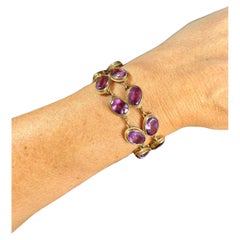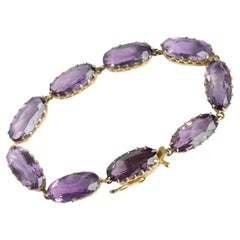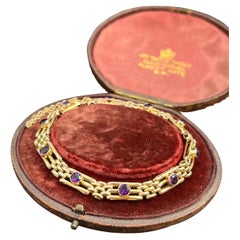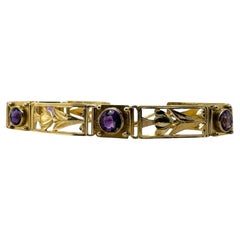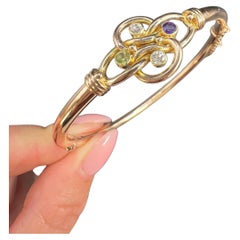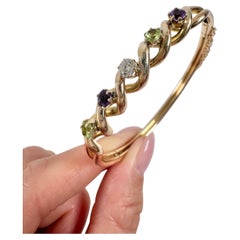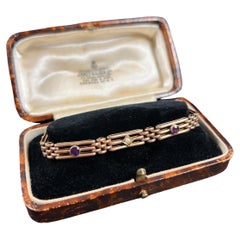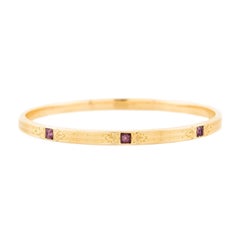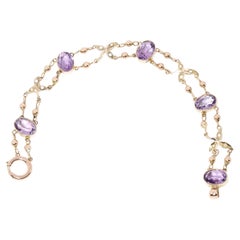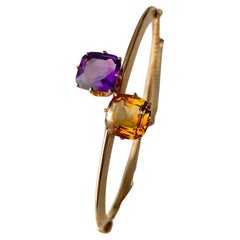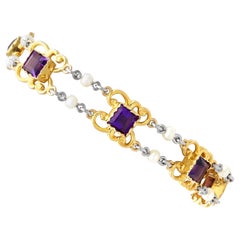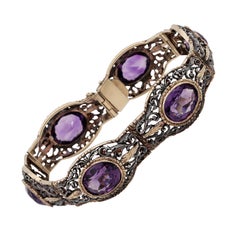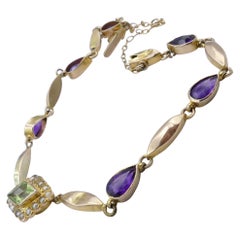Amethyst Bracelet Edwardian
Early 20th Century English Edwardian Chain Bracelets
Amethyst, Gold, 9k Gold
Antique Early 1900s British Edwardian More Bracelets
Amethyst, Gold, 9k Gold
Early 20th Century English Edwardian Link Bracelets
Amethyst, 9k Gold, Rose Gold
Mid-20th Century Edwardian Link Bracelets
Amethyst, Gold, 14k Gold, Yellow Gold
Early 20th Century English Edwardian Bangles
Amethyst, Diamond, Peridot, Gold, 15k Gold
Early 20th Century English Edwardian Bangles
Amethyst, Diamond, Peridot, Gold, 15k Gold
Early 20th Century English Edwardian Link Bracelets
Amethyst, Pearl, 9k Gold, Rose Gold
Vintage 1910s Edwardian Bangles
Amethyst, Gold, 14k Gold
Antique Early 19th Century Unknown Edwardian Link Bracelets
Amethyst, Pearl, 9k Gold, Yellow Gold
Vintage 1910s American Edwardian Bangles
Amethyst, Citrine, 18k Gold
Vintage 1910s Unknown Link Bracelets
Amethyst, Pearl, Gold, 15k Gold, Yellow Gold
Recent Sales
Antique Early 1900s Edwardian Link Bracelets
Amethyst, 18k Gold, Silver
Vintage 1910s British Edwardian Link Bracelets
Amethyst, Pearl, Peridot, 9k Gold, Yellow Gold
Vintage 1920s British Edwardian Link Bracelets
Amethyst, Aquamarine, 15k Gold
20th Century Edwardian Retro Bracelets
Amethyst, Diamond, 18k Gold, Sterling Silver
Antique Early 1900s Unknown Edwardian More Bracelets
Amethyst, 9k Gold
Early 20th Century English Edwardian Bangles
Amethyst, 15k Gold
Antique Early 1900s English Edwardian Chain Bracelets
Amethyst, Peridot, 9k Gold, Yellow Gold
Early 20th Century English Edwardian Bangles
Amethyst, Pearl, Gold, 15k Gold
Early 20th Century English Edwardian Bangles
Amethyst, Pearl, Peridot, 9k Gold, Rose Gold
20th Century British Edwardian Chain Bracelets
Amethyst, Pearl, Peridot, 9k Gold, Yellow Gold
Antique Early 1900s British Edwardian Link Bracelets
Amethyst, Silver
Early 20th Century Russian Edwardian Bangles
Amethyst
Early 20th Century Russian Edwardian Bangles
Amethyst, Diamond, Gold
Antique Early 1900s Edwardian Retro Bracelets
Amethyst, 14k Gold, Yellow Gold
Early 20th Century American Edwardian Bangles
Amethyst, Gold, 14k Gold, Yellow Gold
Antique Early 1900s French Edwardian Link Bracelets
Amethyst, Pearl, Gold
Antique Early 1900s Edwardian Chain Bracelets
Amethyst, Diamond, 18k Gold, Platinum
Antique Early 1900s British Edwardian Link Bracelets
Amethyst, Gold
Antique 1880s British Edwardian More Bracelets
Amethyst, 9k Gold, Gold
Antique Early 1900s British Edwardian Retro Bracelets
Amethyst, Pearl, Peridot, 15k Gold
People Also Browsed
20th Century American Modern Cocktail Rings
Sapphire, Emerald, Diamond, Yellow Gold, 18k Gold
20th Century Chinese Art Deco Hoop Earrings
Diamond, Opal, 10k Gold, Yellow Gold
Vintage 1910s Bangles
14k Gold, Rose Gold
Mid-20th Century More Necklaces
Diamond, Cultured Pearl, Gold, 14k Gold, White Gold
1990s Italian Modernist Cocktail Rings
Diamond, White Diamond, Moonstone, Gold, 18k Gold, Yellow Gold
Early 20th Century English Engagement Rings
Aquamarine, Diamond, 18k Gold, White Gold
Antique 1890s English Victorian Cocktail Rings
Diamond, Moonstone, 9k Gold, Silver
Early 20th Century English Edwardian Drop Earrings
Diamond, Gold, 18k Gold, Platinum
Antique 1890s Unknown Victorian Bangles
Pearl, 15k Gold, Yellow Gold
21st Century and Contemporary American Contemporary Cocktail Rings
Emerald, Diamond, Gold, Yellow Gold, 14k Gold
2010s Tennis Bracelets
Diamond, Emerald, 14k Gold, Yellow Gold
Vintage 1920s Unknown Edwardian Link Bracelets
Diamond, Pearl, Platinum
21st Century and Contemporary Balinese Contemporary Cocktail Rings
Tourmaline, 18k Gold
Antique Early 1900s French Edwardian Beaded Necklaces
Ruby, Natural Pearl, Pearl, White Diamond, Diamond, Platinum, Yellow Gol...
Early 20th Century Art Deco Choker Necklaces
Diamond, Pearl, Natural Pearl, Platinum
Antique 1890s European Late Victorian Dangle Earrings
Diamond, Pearl, 18k Gold, Platinum
Amethyst Bracelet Edwardian For Sale on 1stDibs
How Much is a Amethyst Bracelet Edwardian?
A Close Look at Edwardian Jewelry
Antique Edwardian jewelry is named for King Edward VII of Great Britain, who ruled from 1901 until 1910. Classic Edwardian necklaces, engagement rings, earrings and other jewelry are often overshadowed by the more popular style of the era, Art Nouveau, which is a shame. At its best, Edwardian jewelry was all about the exquisite diamond, platinum and pearl creations made by such famous names as Cartier and Boucheron.
Edward introduced incredibly formal Buckingham Palace court presentations, balls and soirées, resulting in a huge demand for diamond jewels starting with his coronation in 1902. Dozens of tiaras and formal jewels in an updated 18th-century style were purchased from French jewelers Boucheron and Chaumet and from Russia’s Fabergé. The court jewelers Asprey, Garrard, Carrington and the newly opened London branch of Cartier were all overwhelmed with orders for sumptuous diamond jewelry to be worn at the king’s elaborate coronation.
During the Edwardian era, pearls were more valuable than diamonds. The pear-shaped pearl La Peregrina, for example, belonged to some of the most fabulous and strongest women in history and bounced among royal courts in Spain, France and Russia for several centuries. So while today the scale and clarity of a diamond ring matters, back then the size and quantity of your pearls was more important a declaration of wealth. And just as Victorian notions of propriety and femininity began to change after Queen Victoria died in 1901, jewelry design also evolved but there was some overlap with late Victorian styles.
Women of the Edwardian period sported bejeweled headpieces like tiaras and bandeaus with feathered aigrettes. Another popular piece of jewelry that is said to have been directly inspired by Queen Alexandra were colliers de chien, or dog collars — today's choker necklaces — which consisted of either a ribbon decorated with a brooch, a gemstone or several strands of pearls strung closely together.
Two major jewelry houses, Cartier and Boucheron, were founded in the mid-1850s, and by the beginning of the 20th century, the wealthy considered them household names. The Cartier brand became even more desirable once the house became the official jewelry supplier to King Edward VII. Cartier took this title seriously and designed some of the most innovative jewelry of its day, since it was willing to experiment with new materials like platinum and because it was mindful of fashion trends. Filigree settings also became popular. This saw-piercing technique was decorative and at the same time created a sense of lightness.
Perhaps even more important than Cartier’s use of platinum was the founding of De Beers Consolidated Mines Limited in 1888. The discovery of new diamond mines made the stone more affordable and prompted the introduction of new gemstone cuts. It is not uncommon to see Edwardian jewels with baguette or briolette diamonds.
Find antique Edwardian rings, bracelets, watches and other jewelry on 1stDibs.
Why Gold Shines in Jewelry Craftsmanship
Gold is the feel-good metal, the serotonin of jewelry. Wear vintage and antique gold necklaces, watches, gold bracelets or gold rings and you feel happy, you feel dressed, you feel, well, yourself.
Gold, especially yellow gold, with its rich patina and ancient pedigree going back thousands of years, is the steady standby, the well-mannered metal of choice. Any discussion of this lustrous metal comes down to a basic truth: Gold is elementary, my dear. Gold jewelry that couples the mystique of the metal with superb design and craftsmanship achieves the status of an enduring classic. Many luxury houses have given us some of our most treasured and lasting examples of gold jewelry over the years.
Since its founding, in 1837, Tiffany & Co. has built its reputation on its company jewelry as well as its coterie of boutique designers, which has included Jean Schlumberger, Donald Claflin, Angela Cummings and Elsa Peretti. There are numerous gold Tiffany classics worth citing. Some are accented with gemstones, but all stand out for their design and the workmanship displayed.
For the woman who prefers a minimalist look, the Tiffany & Co. twist bangle (thin, slightly ovoid) is stylishly simple. For Cummings devotees, signature pieces feature hard stone inlay, such as her pairs of gold ear clips inlaid with black jade (a play on the classic Chanel black and tan), or bangles whose design recalls ocean waves, with undulating lines of lapis lazuli and mother-of-pearl. And just about any design by the great Jean Schlumberger is by definition a classic.
Even had he eschewed stones and diamonds, Southern-born David Webb would be hailed for the vast arsenal of heavy gold jewelry he designed. Gold, usually hammered or textured in some manner, defines great David Webb jewelry. The self-taught jeweler made very au courant pieces while drawing inspiration from ancient and out-of-the-way sources — East meets West in the commanding gold necklaces made by Webb in the early 1970s. The same could be said for his endlessly varied gold cuffs.
In Europe, many houses have given us gold jewelry that sets the highest standard for excellence, pieces that were highly sought after when they were made and continue to be so.
Numerous designs from Cartier are homages to gold. There are the classic Trinity rings, necklaces and bracelets — trifectas of yellow, white and rose gold. As a testament to the power of love, consider the endurance of the Cartier Love bracelet.
Aldo Cipullo, Cartier’s top in-house designer from the late 1960s into the early ’70s, made history in 1969 with the Love bracelet. Cipullo frequently said that the Love bracelet was born of a sleepless night contemplating a love affair gone wrong and his realization that “the only remnants he possessed of the romance were memories.” He distilled the urge to keep a loved one close into a slim 18-karat gold bangle.
BVLGARI and its coin jewelry, gemme nummarie, hit the jackpot when the line launched in the 1960s. The line has been perennially popular. BVLGARI coin jewelry features ancient Greek and Roman coins embedded in striking gold mounts, usually hung on thick link necklaces of varying lengths. In the 1970s, BVLGARI introduced the Tubogas line, most often made in yellow gold. The Tubogas watches are classics, and then there is the Serpenti, the house's outstanding snake-themed watches and bracelets.
A collection called Monete that incorporated the gold coins is one of several iconic BVLGARI lines that debuted in the 1970s and ’80s, catering to a new generation of empowered women. Just as designers like Halston and Yves Saint Laurent were popularizing fuss-free ready-to-wear fashion for women on the go, BVLGARI offered jewels to be lived in.
Since Van Cleef & Arpels opened its Place Vendôme doors in 1906, collection after collection of jewelry classics have enchanted the public. As predominantly expressed in a honeycomb of gold, there is the Ludo watch and accessories, circa the 1920s, and the golden Zip necklace, 1951, whose ingenious transformation of the traditional zipper was originally proposed by the Duchess of Windsor. Van Cleef's Alhambra, with its Moroccan motif, was introduced in 1968 and from the start its popularity pivoted on royalty and celebrity status. It remains one of VCA’s most popular and collected styles.
Mention must be made of Buccellati, whose name is synonymous with gold so finely spun that it suggests tapestry. The house’s many gold bracelets, typically embellished with a few or many diamonds, signified taste and distinction and are always in favor on the secondary market. Other important mid-20th-century houses known for their gold-themed jewelry include Hermès and Ilias Lalaounis.
Find a stunning collection of vintage and antique gold jewelry on 1stDibs.
The Legacy of Amethyst in Jewelry Design
There are few gemstones in the world that are both affordable and worthy of a duchess’s attention. But then not many stones are as beautiful as amethyst. Indeed, vintage and antique amethyst jewelry has innumerable fans, and February’s birthstone has many unique attributes. For the romantics, there are several tales in Greek mythology that tell the story of Bacchus and Amethyste, a maiden that he pursues yet is rescued by Diane by turning her into a white stone. Bacchus, mourning his love, pours a glass of wine over the sculpture, dyeing her purple.
Amethyst has adorned many royal jewels. One of the most enviable jewelry collections of all time belonged to Wallis Simpson, the Duchess of Windsor. In 1947, the Duke gifted her with a Cartier amethyst and turquoise bib necklace. This special order piece was made with twisted 18-carat and 20-carat gold, platinum, brilliant- and baguette-cut diamonds, one heart-shaped faceted amethyst, 27 emerald-cut amethysts, one oval faceted amethyst, and turquoise cabochons. The Duchess was not the only Royal with a penchant for the purple gemstone. The tiara now owned by Queen Silvia of Sweden is set with amethysts that once belonged to the French Empress Josephine. A stunning 56-carat cushion-cut, square-shaped amethyst set in an 18-karat yellow gold necklace designed by Tiffany & Co. is now in the collection of the Smithsonian National Museum of Natural History.
The Smithsonian also has in its possession an even more rare example of fine amethyst: the 96-carat Morris Amethyst Brooch. The brooch features a deep, rich purple heart-shaped amethyst. The museum states that the piece was likely made during the Edwardian period (1901–15) “when platinum and diamonds were often used, and amethyst, a favorite stone of King Edward VII’s wife, Alexandra, was often included in jewelry of the era.”
Another amethyst necklace, with an even richer story, can be found in the Natural History Museum of London. Known as the Delhi Purple Sapphire (even though the stone is an amethyst), this stone was stolen from the Temple of Indra during the Indian Mutiny of 1857. Anyone in possession of this stone is bound to have terrible luck, including its owner Edward Heron-Allen, who gifted the gemstone to the museum thinking that this would save him but ended up transferring the bad luck to the museum curators overseeing the stone.
Find a wide range of vintage and antique amethyst necklaces, bracelets and other fine jewelry on 1stDibs.
Finding the Right Bracelets for You
Today, antique and vintage bracelets are versatile and universally loved accessories that can add polish and pizzazz to any ensemble.
Bracelets were among the jewels discovered to have been buried with Pharaoh Tutankhamun when his tomb was unearthed in 1922, and wrist and arm bracelets were allegedly worn by Queen Puabi in Sumer, southern Mesopotamia. But preceding the adornments of Ancient Egypt and elsewhere, the people of prehistoric times likely wore the decorative accessory, fashioning it from shells and fish bones. When the Bronze Age allowed for more durable materials and semiprecious stones to be incorporated into jewelry, bracelets became a treasured symbol of wealth.
In the thousands of years following the debut of the world’s first bracelets, the artistry behind this common accessory has only broadened, with designers at popular jewelry houses growing more venturesome over time. David Webb looked to nature for his Animal Kingdom bracelets, and for her best-selling bracelets and more at Tiffany & Co., Elsa Peretti would frequently do the same. From bangles to tennis bracelets, the modern age offers plenty of options.
Internationally acclaimed bracelet designs have on occasion become powerful symbols of status, style and, in the case of Cartier's iconic design, love. The Cartier Love bracelet can be found on the wish list of most jewelry lovers and on the wrist of some of the world’s biggest stars. Its arrangement of mock screwheads and distinctive functionality — it was initially locked and unlocked with an accompanying vermeil screwdriver — is an enduring expression of loyalty, unity and romance. (Do you know how to spot a fake Cartier Love bracelet?)
While the Love bracelet has played a role in the skyrocketing popularity of cuff-style bracelets, they are far from the only glamorous option for collectors. Make a statement with an Art Deco design, a style that sees all kinds of iterations fitted with studded cuffs, one-of-a-kind shapes and dazzling insets. A chunky vintage gold bracelet in the Retro style will prove eye-catching and elevate any outfit.
One of the best things about bracelets, however, is that you never have to choose just one. Style icon Jacqueline Kennedy stacked her Croisillon bracelets — designed by Jean Schlumberger for Tiffany & Co. — with such frequency that the ornate bangles were eventually dubbed “Jackie bracelets” by reporters. Contemporary silver pieces can easily complement each other, rendering a layering of luxury almost a necessity.
Find a diverse collection of bracelets that you can sort by style, stone cut and more on 1stDibs.
